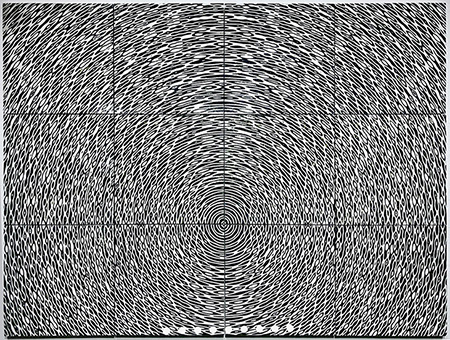
Continuing through December 2, 2023
Christopher Badger teaches classes in design, digital media, and coding at Santa Monica College. In his exhibition “Ideas Without Edges,” Badger presents artworks that stem from assignments he has given to his students. On view are his own responses to prompts such as "Chemical Painting," "Computational Choreography," "Psychological Color Theory," "Sculpture as a Model of Physical Phenomena," and "Mathematical Composition of the Picture Plane." Badger thinks beyond the obvious. Rather than use code to create screen-based works that merely illustrate these ideas, he reveals the process of their making — complicated algorithms — and uses code to create physical objects.
While one of the first works we see when entering the large gallery space is mathematical — a set of spiral bound notebooks placed vertically between two red bookends on a wooden table — it is presented in an analog format. Badger fills fourteen volumes with the 24,862,048 digits that make up the largest known prime number. For this work, “What is a Number?” Badger invites us to take the time to look through the printed pages and to reflect on how expansive that number actually is. This work is both literal and conceptual, setting the tone for the entire exhibition.
“Incremental Information” hangs adjacent to “What is a Number?” It is a suite of five digital prints that document the gradual pixelation and disintegration of a black and white photograph of light on water. The five pictures sequentially represent higher and higher levels of magnification so the image eventually breaks down to become an abstract pattern of black and white squares. For those who are not used to thinking about the relationship between images and pixels, the sequence is revelatory.
The works become increasingly complex and complicated as Badger delves into systems that repeat to produce shapes and marks that are combined in different ways. For example, “Interference Field” is a large wall work consisting of iron blue pigment, gesso, and joint compound on plywood. The work is a physical manifestation of custom software that models interference patterns of ripples and waves on water. The interference algorithm was fed into a laser engraver, which was instructed to remove layers of pigment off the gessoed ground, leaving a pattern of deep blue marks that spiral out from the center to create what appears to be an atmospheric vortex suggestive of a celestial expanse.
The largest and most colorful work is the multi-panel “Vanishing Points.” This work investigates a formal system — specifically Wang Tiles— and presents eleven squares, each made up of four isosceles triangles of any of four different colors. Presented in a line, the work explores the infinite tiling of a plane. The presentation concludes that the sequence is aperiodic (irregular) rather than periodic. While the intentions are to illustrate computational systems, the resulting color choice and sequence has conceptual precedents in the sequential ordering practiced by the likes of Sol LeWitt and Ellsworth Kelly. Badger's pieces (though not interactive) are also reminiscent of the code-based sculptures by Daniel Rozin, a professor of digital media at NYU.
Many of Badger's works are derived from "instructions" that are based on code and then translated by machines that make analog outputs from these digital files. For example, wood works like “Interference Field” are created by sending the software to a CNC milling machine. Visually, what stands out is the relationship between chaos and control and how programmed algorithms can create the unexpected. It makes sense here to revisit LeWitt, who created explicit directions for the making of his wall drawings, where length, color, and direction of lines were verbally described, to be followed (with freedom for interpretation) by the person installing the piece on site. While theoretically the works could be the same each time they're exhibited, in practice, they never are. Similarly, what is striking in Badger's explorations is the way software, which is specific and objective, can be outputted to create vastly different results.
